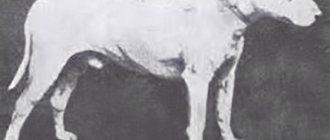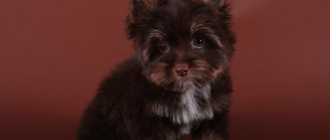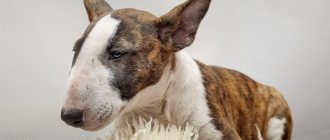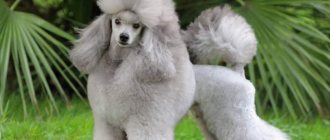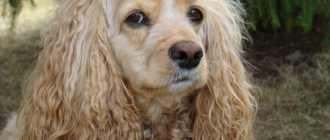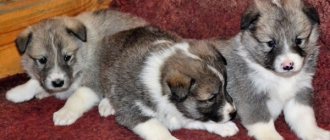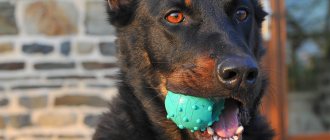Bull Terrier dogs were developed by crossing a Bulldog and several terrier breeds.
The goal is to improve fighting qualities to participate in dog fights.
After the activity was banned in Europe, dogs were used as watchdogs, guards and companions, as well as for hunting small rodents.
This breed is distinguished by its pronounced fighting qualities and non-standard appearance.
Breed card
- Known breed names : English Bull Terrier, Mini Bull Terrier
- FCI breed number: 11
- Standard on the FCI website (English) : link
- Height at the withers : adult male - up to 45 cm, female - up to 39 cm
- Weight of an adult dog : males - up to 33 kg, females - up to 28 kg
- Color options : white, brindle, sand, tricolor, addition to white
- Life expectancy : up to 12-14 years
- Puppy cost : up to 40 thousand rubles
- Size : 4 out of 5
- Learning ability : 4 out of 5
- Attitude towards children : 4 out of 5
- Shedding intensity : 3 out of 5
- Protective and guard qualities : 5 out of 5
Breed characteristics
In appearance, this is the most muscular and strong representative of bull terriers.
Externally, the head tapers, is powerful, long, and resembles a rat’s. But without defects, it looks disproportionate compared to the body. Scissor bite. The nose is large, pronounced and has large nostrils.
The eyes are triangular in shape and noticeably small in size in relation to the head. When choosing a bull terrier puppy, pay attention to the jaw. There should be 12 teeth in total. As you get older, your ears become larger. The hind and forelimbs are powerful, slightly crooked, stable. The body is round and proportional. An adult dog has a strongly muscled chest and the chest protrudes forward. A straight tail that tapers towards the bottom.
There are artificially bred mini-bull terriers that have the same structure, the same colors, but the size of the animal is smaller.
FCI breed standard: No. 11
Exterior. This is a strong, strong dog. The muscles are developed, it looks harmonious and has no significant defects, it looks compact, with notes of intelligence.
Characteristic. The Bull Terrier is the gladiator of the terrier tribe, hardy, stubborn and assertive. The breed is recognizable by the expression and structure of the muzzle; it is oblong and egg-shaped. Sexual dimorphism is pronounced regardless of the size of the animal.
Temperament. Submits to discipline, stubborn, but there is balance. Despite the fact that the breed is a fighting dog, the dog treats people well.
Bull Terrier: all about the dog, photo, breed description, character, price
Size, weight and height of the breed
The dog does not have an established standard, since it has been artificially changed over time. A normal adult typical bull terrier weighs up to 30-33 kg. Average height can be reached 45-47 cm.
The Miniature Bull Terrier has more limited parameters. The height of an adult does not exceed 35 cm. But the weight can reach 30 kg depending on the level of muscle mass.
This dog must have a harmonious structure and physical shape. He should not be too fat or very thin, without muscles.
Possible colors
- White without spots. With possible pigmentation on the abdomen.
- Black
- Turtle color
- Reddish
- Ginger
- Sand brown
- Two-color
It is also possible to have bluish or deer-colored blotches on snow-white fur.
Puppy weight by month
A dog's weight depends on development. This includes muscle mass, since the dog is active and its exterior is very powerful. The weight of a standard bull terrier puppy is:
- at 2 months – 4.7 kg.
- at 3 months – 8.2 kg.
- at 4 months – 12.1 kg.
- at 5 months – 15.5 kg.
- at 6 months – 18.9 kg.
- at 7 months – 23.8 kg.
- at 8 months – 25.4 kg.
- at 9 months – 27.2 kg.
- at 10 months – 28.9 kg.
- at 11 months – 30 kg.
- One-year-old bull terriers normally gain up to 33 kg.
Females are slightly smaller with less defined muscles. In the first months, their weight is about 3.5-4 kg. They do not develop as rapidly as males. By the age of one year, their weight reaches 29 kg.
English Bull Terrier: photo and description of the breed, price and reviews
Lifespan
A dog with normal development can live up to 13-14 years. In this case, it depends on the dog’s physical activity. Cardiovascular problems are possible. In this case, the dog can live about 10 years. If you don't eat right, your lifespan will also decrease by a year or two. Chronic diseases can affect the life of an animal.
Allergenicity
The dog's fur is hard and there is a greater chance of developing an allergic reaction. Although the animal has short hair, it is not hypoallergenic, even in dogs with completely white hair. She sheds twice a year, but not very intensely; it is enough to brush several times a week to avoid sharp hairs at home.
Description of the standard
The English Bull Terrier is a medium-sized dog, powerful and harmonious. He is muscular, hardy, easily tolerates heat and cold, and tirelessly covers dozens of kilometers with his characteristic elegance.
Even in the photo the bull terrier looks full of strength and energy. Due to its characteristic egg-shaped elongated muzzle, it cannot be confused with any other dog.
Varieties and colors
The Bull Terrier standard provides for the following breed types:
- standard – height 40-55 cm, weight 20-25 kg;
- mini bull terrier: breeding began in the 30s of the 20th century, recognized in 1991, reaches 35.5 cm at the withers, body weight up to 8 kg.
The following colors of bull terriers are distinguished:
- black and brindle and tan;
- white bull terrier - can be pure white or with spots on the head;
- brindle yokras;
- single-color – black, fawn (red), fawn or brown with a mask on the face;
- bicolor - colored spots of any shade in combination with white, the latter should not exceed 20%;
- tricolor - bull terriertricolor comes in any combination of colors.
Two-tone colors of bull terriers with a predominance of white, one-color with spots and specks on the body are prohibited. The tricolor bull terrier should have color proportions of 1:1:1. Defects also include liver and blue suits.
General requirements
The standard bull terrier and mini bull terrier differ only in size. Otherwise, their exterior is the same.
The photo shows a standard and mini boule
| Parameter | Description |
| Dimensions | The maximum height for a mini-bull is 35.5 cm, for a regular bull terrier - 40-55 cm. It is advisable for females to be at the lower mark, and males to be at the upper mark. |
| Constitution | Firmly lean, with defined muscles. |
| Frame | Square. The back and loin are short and muscular. The neck is long, stands high, the withers gradually merge into the top line, and the croup is convex. The chest is deep, the stomach is moderately tucked. |
| Head | Ovoid, long, with a smooth arch, directed downwards. The forehead is flat, the muzzle is deep. |
| Lips | Without fleshiness, tightly cover the teeth. |
| Bite | Scissor-shaped, in dogs over 3 years old, tight or straight is allowed. |
| Ears | Small, standing high and close to each other. The tips are rounded and point upward. |
| Eyes | Small, triangular, standing high, oblique and close. The slit is narrow. The iris and eyelids are dark. |
| Nose | Black, with a large lobe, lowered down. |
| Limbs | Smooth, parallel, widely spaced. The length of the front joints is equal to the distance between the elbows, the height of the hind joints to the hocks is the same as the space between them. |
| Paws | Collected into a ball, round, the pads are strong. |
| Tail | It stands low, short, tapering from base to tip. The dog holds it horizontally. |
| Wool | Straight, hard, thick, shiny, close to the body. In the autumn-winter period, a thin undercoat appears. |
History of the breed
Before the breed was banned in 1835 by the German Convention, bulls were poisoned with dogs in England. The Bull Terrier is the ancestor of the English Bulldog. Only the exterior was different: the legs were higher, but powerful, with a large square head, the dog quickly dealt with the victim. This method of baiting began to be prohibited, and people hunting for profit staged brutal dog fights. An arena for such entertainment was organized in small pubs, where a poor or a rich man could come.
But the bulldogs, in their still unformed form, could not cope with this method of money laundering. What was needed was great strength, endurance, anger and cunning. And the bulldogs of that time were distinguished by their softness, more melancholy.
Experiments were carried out on the breed, they began to cross it with other representatives. Terriers turned out to be the most suitable for this. Strength and perseverance only increased, physical activity and power appeared. The fighting dogs were called "Old Bull and Terriers". These were the ancestors of today's bull terriers.
Character
When you mention that the dog is a fighting dog, unkind images appear in your head. But, the character of any animal directly depends on upbringing and relationship with the owner. This is a rather stubborn dog, with developed intelligence, although many do not think so.
The breed is suitable for energetic people, since the pet does not sit still, it is in constant motion.
They do not feel pain, since they have endings located far apart from each other. The nose remains very sensitive.
Fights were carried out only between animals of the same breed, equally angry and strong. Each animal was controlled by a person, and the bull terrier depended on the owner. Dogs are not aggressive towards people. There should be no inadequate individuals left in the litters.
If you start raising a bull terrier incorrectly from childhood, he will show aggression. This is a jealous and capricious dog. He enters into submission or obedience reluctantly and even as a puppy resists. Education will require strength and perseverance to immediately show who is boss in the house. The dog quickly responds to love. If they see the strength of the owner and trust him, they will become best friends and serve faithfully until the end of their days.
Bull Terrier: advantages and disadvantages of keeping
Key points in training
Training and education of Bull Terriers is the main concern of all owners. If improperly or poorly trained, a dog can become uncontrollable and dangerous. You can contact a professional dog handler.
First of all, the puppy is taught a name, a place to sleep, and the dominance of the owner in the house. All negative habits must be stopped, the dog must be punished. The Bull Terrier's intelligence helps to identify a person's weaknesses; they need a very firm hand.
Read about how to properly train a dog in the article: “Training a puppy: effective methods from dog handlers, learning commands at home.”
They were capable students, but stubborn. It takes a long time to complete the basic commands:
- "Near";
- "Place";
- "It is forbidden";
- "Quiet".
It is impossible to stimulate and encourage aggression and hatred towards animals and people. Early socialization is important in education.
Learning ability
The adaptation of bull terriers is quite developed. This plays an important role in education. Dogs are able to determine a person’s mood; by the smallest changes in a person’s voice, they determine the situation and possible action.
The breed has a peculiarity: they obey one owner. They love all members of the household, but are especially devoted to only one, whom they independently choose in childhood.
If a dog is a fighting breed, this does not mean that force and shouting should be used when training and raising it. The dog will show aggression if he sees that aggression is being shown towards him. In this matter you need to be patient and stubborn. And in the first months of the animal’s life, you need to devote as much time as possible to it, since the dog becomes attached to people, it cannot stand loneliness and must constantly participate in the life of the household. And the owner must pay enough attention to the pet, be kind, but strict. The sooner the dog is shown that it must obey, the more obedient it will be.
Feeding
Puppies grow quite quickly, gaining height by nine months. After this age, the animal's development consists of muscle development. What should a bull terrier's diet be?
Remember that this breed quickly gains excess body weight. Eventually:
- the breed requires one meal per day;
- Be sure to teach your pet to seek food only when hungry;
- do not add more food than you should;
- do not offer gourmet foods so as not to spoil your pet;
- the main part of the diet is natural meat products;
- the second part of the meal is foods with minerals and calcium.
Protective and guard qualities
Bull Terriers are true guards. They are instantly able to assess the situation and act in case of danger. The dog protects its family and its home. Bitches have a greater predisposition to protection.
Any of the representatives of this specific breed captures facial expressions, movements, intonation with lightning speed and great accuracy; they are excellent psychologists.
Bull Terrier dog - characteristics of the breed, black and white color
Health
In general, Bull Terriers are dogs with good health, although they are not immune to allergies.
- You need to pay attention to the bull terrier's paws, the area around the eyes, ears, area around the muzzle; if redness appears there, you need to contact a veterinary dermatologist.
- Before buying a white bull terrier, you need to make sure that it is really white and not an albino dog, the health of the latter is much weaker, so it is best to take a pet from official breeders.
Content
Adaptation of a puppy after purchase is very fast and allows you to adapt to life in a small apartment or in a private sector. There should be no closed rooms for them, as they escort a person from room to room. The dog should have its place near the room, or better yet, near the owners’ bed, since the bull terrier will not be able to sleep peacefully without checking if there are people there. It is also not worth changing the places of the animal’s personal bowls.
Need for physical activity
The breed is very hardy and needs muscular activity. They must be in constant activity and develop muscles. It is not uncommon for diseases to develop if the dog does not expend enough energy. In this case, the character of the animal changes, the dog becomes angry and uncontrollable.
This will take time for the dog to expend enough energy, you need to facilitate this. If you leave your pet alone at home all the time, he will begin to destroy everything around him out of boredom, which will cause obvious discomfort to people. It is necessary to walk the dog for a long time. At least 3 hours of active time in the fresh air should be spent per day. You can go jogging or cycling together. Just taking your dog to the stadium and working out together will help you become friends.
Appearance care
There are no special requirements for caring for animals. Their fur needs to be brushed regularly to prevent shedding from negatively affecting the cleanliness of the house. It is recommended to wash your pet rarely; after walks, it is enough to wash its paws. You need to clean your ears and wipe your eyes with a soft cloth.
Nutrition
Bull Terriers from two years of age should eat twice a day. The first meal occurs at lunchtime; the diet should include food rich in calcium and fats: boiled meat, cottage cheese and other fermented milk products, vegetables and fruits. The second meal should take place in the evening. This may include raw beef or boiled fish fillets. By-products can also be included in the diet. Hercules is excluded, and other cereals can be given once a week. Tubular bones are not recommended; the dog does not digest them well. Small bull terriers should receive enough vitamins.
It is better to serve food at a high level, attaching the toe to special handrails or stands. The top line of the toes should reach the dog's chest.
Bull Terrier: description and characteristics of the breed
Basics of care
Bull Terriers do not need a lot of space, so they are suitable for keeping in a small apartment. These dogs need to walk outside a lot and play active games. Provide your puppy with a private sleeping area from which he can explore the room. To avoid allergies, buy your dog a bed only made from natural material.
The owner will not need much knowledge about the care and maintenance of a representative of this breed. The Bull Terrier's coat does not require trimming.
It is enough to bathe him up to four times throughout the year; dirt from the wool is removed with damp cloth wipes.
The pet requires brushing with a rubber brush once every seven days. This removes excess hair and massages the skin. It is necessary to regularly care for the ears and mucous membranes of the eyes; they are wiped with a cotton pad. Once a month, the claws are trimmed a few millimeters using special scissors.
Bull Terrier Diseases
Bull Terriers rarely get sick with anything serious, but the following common pathologies are possible:
- Deafness
- Elbow dislocations
- Renal polycystic disease
- Aortic stenosis
- Mastocytoma
- Inversions and inversions of the eyelid
- Skin burns, especially in white-haired breeds
- Skin diseases: demodicosis, mites
- Eye problems
But diseases can depend on many external factors: heredity, dietary habits, etc.
Where to buy a puppy
A puppy under the age of 3 months is purchased. It is recommended to select this breed from special nurseries. You cannot pick up a puppy without documents, there is a high risk that it is sick or a fake representative of terriers. Kennels spend two months collecting all the necessary documents, administering vaccinations, and weeding out unsuitable puppies.
Bull Terriers are quite expensive and rare, since it was difficult to fully renew the breed after it was banned by the convention. The cost of a puppy depends on the popularity of the kennel, pedigree, and prospects. Therefore, the pricing policy can reach 70,000 rubles. Approximate prices for a good, healthy bull terrier puppy from 30 thousand to 60 thousand rubles.
Upbringing
You need to start raising a bull terrier puppy from the moment it arrives in its new home. Future owners need to prepare in advance and learn some techniques.
It is necessary to clearly explain to the dog where the toilet and food are, and that you should not chew things.
There are certain rules of communication:
- At first, it is advisable to devote more time to the dog, play and talk with it. This will strengthen trust and mutual understanding between the dog and the owner.
- Analyze and try to understand the reasons for the actions and behavior of the animal.
- Show calm and patience when training your dog.
- Never lose your temper and punish your dog unnecessarily.
